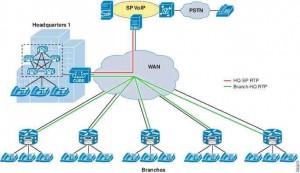 Telecommunication expenses have been a hot topic of discussion among organizations and CIOs who want to reduce the unnecessary business communication expenses. In a bid to curtail the costs, organizations are switching from the TDM services to SIP. The latest SIP technology has several advantages and the SIP trunks are deployed using two different models – distributed and centralized. Both the models have their individual merits and demerits and as the technical head of your company, you will have to weigh the pros and cons carefully before finalizing.
Telecommunication expenses have been a hot topic of discussion among organizations and CIOs who want to reduce the unnecessary business communication expenses. In a bid to curtail the costs, organizations are switching from the TDM services to SIP. The latest SIP technology has several advantages and the SIP trunks are deployed using two different models – distributed and centralized. Both the models have their individual merits and demerits and as the technical head of your company, you will have to weigh the pros and cons carefully before finalizing.
Organizations using Unified Communications and IP telephony prefer the use of SIP or Session Initiation Protocol. All the major IP communication products support the SIP as it is being adopted by many organizations across the globe. SIP based solutions can replace the Legacy telephone structure and facilitate the convergence of video, voice and UC traffic on the same platform. This would inadvertently help the company save a lot of money, which can be used for other core business activities. In this article, we are going to take a look at the features offered by the two primary SIP trunking models:
Centralized SIP trunking:
In this topology the SIP trunks are installed in the data centre hubs. Here the external calls are usually backhauled to the corporate WAN. All the interoffice communications are transmitted over the WAN. This is the most popular trunking topology followed by almost 60% of the companies in Europe and US. This deployment model is in fact the most appropriate for the companies that uses IP PBX or UC servers in the central data centers. The centralized model is successful in reducing the CAPEX and OPEX through the consolidation of trunks and elimination of inefficiencies.
The only problem with this model is that you would require going for regular capacity management and traffic engineering. There must be proper apportioning of SIP trunking pool to meet the session demand across the enterprise. The WAN should also be engineered in a proper manner to lead to low latency site-to-site connectivity for accommodating the delay sensitive traffic like IP video.
Single point of failure should also be addressed while designing the network in order to ensure service continuity during important business communications. In order to achieve this, majority of the organizations deploy SIP trunking at two data centers for maintaining PSTN connectivity.
Distributed Topology:
This is one topology used by the companies that employ a decentralized UC or IP PBX. The migration path followed by this model is pretty simple and does not require too much network planning or engineering. In this model the legacy PRI circuits are all substituted by the SIP trunks. Every site operates individually and has its own SIP trunks, which isolates a particular site and the problem is arrested to a particular site.
However, the biggest disadvantage of distributed model is that it fails to deliver the financial advantages, which one often gets to avail after implementing the centralized SIP trunking.
You will have to understand your requirements and accordingly take a decision as to how you can solve your communication issues.
About The Author
Michelle Patterson is excited with the new technologies that are threatening to change the way we stay in touch and communicate, particular in business. She works with companies that are introducing these technologies to make understanding them easy for regular people.